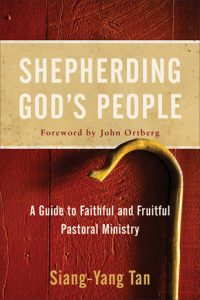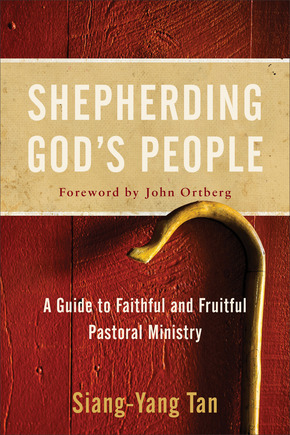Tan, Siang-Yan. Shepherding God’s People: A Guide to Faithful and Fruitful Ministry. Grand Rapids: Baker, 2019, 263 pages, $22.99, paperback.
Originally from Singapore, Siang-Yang Tan (PhD, McGill University) serves as professor of psychology at Fuller Theological Seminary and senior pastor of the First Evangelical Church in Glendale, California. Tan has authored fourteen books and serves in editorial roles for several academic journals. If only a single word were used to describe this volume, one might settle on “comprehensive.” Indeed, this is how John Ortberg describes the book in his preface. A quick perusal of the table of contents, and a thorough reading of its content reinforces the comprehensive nature of this overall project. From the beginning of the book, readers sense Tan’s commitment to plunge into the deep waters of pastoral ministry. Guided by an expert with more than thirty-five years of experience under his belt, this volume comprehensively covers the critical aspects of a faithful shepherding ministry.
Divided into two overall sections, part one consists of the first four chapters. Here Tan introduces readers to select fundamentals of pastoral ministry: a biblical perspective on ministry, the essential role of the Holy Spirit, the spiritual life of a pastor, and the personal life of the pastor. In part two, Tan identifies sixteen primary areas of pastoral ministry and devotes a chapter to each area. Some of the topics covered in these chapters include traditional components of a church service (teaching, worship, etc.), leadership (mentoring staff, volunteers, working with church boards, integrity), church ministries (small groups, missions, counseling), weddings, funerals, and the always-difficult period of time when a pastoral change occurs. In each of these areas, Tan combines a wealth of personal experience and a deep reserve of critical research. While including aspects of his personal experience throughout the volume, the substance of his assertions are grounded within the biblical text and from church tradition. Thus, his presentation avoids the idiosyncrasies often found in similar volumes. Due in part to its scope, the amount of information presented in this comprehensive book is both its greatest strength while also being a conditional weakness.
How one approaches this volume will determine its suitability for integration into ministry. Because pastors have a wide array of concerns, it proves impossible to know what readers expect from a book on pastoral ministry. Some readers desire well-researched data, while others seek personal stories and experiences shared by an expert in the field. Some readers seek a specific list of things to do, while others want less of a list and more of a challenge to thoughtfully explore areas that may not have been top-of-mind prior to consuming the text. The challenges notwithstanding, this book has import for each interested reader. In John Ortberg’s preface, he claims “You might think of this book as a kind of career syllabus for pastors” (p. xii). This apt description aids in preparing the reader to tackle the material that follows. Each chapter contains topical lists related to the chapter’s material. The lists are usually numbered, comma-delimited, or parenthetical inserts. Quite often, a specific item in each list is then further broken down into another sub-list. Tan clearly indicates his sources, which are numerous, and the end of each chapter presents a list of recommended reading for further study.
The comprehensive nature of Tan’s work is seen primarily in its breadth, not depth. Tan’s broad research forms an excellent foundation for his chapter materials, and the extensive lists proves exhaustive, even though readers may find his explanations lacking. Some are not explored in-depth, which is understandable given the need to limit the length of the book. Yet the lack of explanation stifles the application for some of the material. While none of the lists are superfluous, some deserve a dedicated chapter. Thus, a prospective reader would do well to take notes on the items that pique their interest or where the Holy Spirit nudges for further investigation, then consult the citations at the end of the book as a guide for what materials to use for more in-depth research and understanding.
Books on pastoral ministry run the entire gamut of styles. Because of the vast array of current monographs on pastoral ministry, readers can struggle to determine which ones are worth purchasing. If one is looking for a book that elucidates on years of personal pastoral experience through powerful, impactful stories, this volume will not suffice. If an individual is looking for a deep theological dive into one or two keys areas of pastoral ministry utilizing deep exploration, cultural context, or detailed word study, one will not find this work fulfilling. Instead, Tan’s volume presents a survey of pastoral ministry with thoughtful inclusions of and additional resources. As such, this volume best serves as a starting source for pastoral ministry. It may not contain the suggested answers a reader may expect to find on a given topic, but it provides a survey of thought on pastoral ministry topics and it points readers to resources they can use to find their own answers. As such, pastors from any expression of the Christian faith can feel good about adding this book to their personal reference collection.
Eric Odell-Hein
Columbia Evangelical Seminary, Washington





